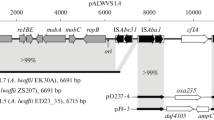Abstract
A Tn917 mutant ofStaphylococcus carnosus TM300, nrIII, was isolated and characterized. Mutant nrIII did not take up nitrate or accumulate nitrite when grown in B-medium supplemented with up to 10 mM nitrate under anoxic conditions; however, it displayed wild-type levels of benzyl Δ viologen-linked nitrate reductase activity. Cultivated in B-medium with nitrate under oxic conditions, mutant nrIII accumulated fivefold less nitrite than the wild-type. The mutation inS. carnosus nrIII could be complemented with a 2-kb chromosomalEcoRI-HpaI fragment from the wild-type. The gene affected by transposon insertion in mutant nrIII was cloned and sequenced. Analysis of the deduced amino acid sequence revealed that this gene, designatednarT, encodes a highly hydrophobic 42-kDa transmembrane protein of 388 amino acids and shows similarities to transport proteins that play a role in nitrate import or nitrite export. The inability of nrIII to take up nitrate under anoxic conditions and its ability to take up and accumulate nitrite in the presence of benzyl viologen, a nitrate ionophore, under the same conditions suggest that NarT represents a transport protein required for nitrate uptake under anoxic conditions inS. carnosus.
Similar content being viewed by others
References
Augustin J, Götz F (1990) Transformation ofStaphylococcus epidermidis and other staphylococcal species with plasmid DNA by electroporation. FEMS Microbiol Lett 66:203–208
Augustin J, Rosenstein R, Kupke T, Schneider U, Schnell N, Engelke G, Entian KD, Götz F (1992) Genetic analysis of epidermin biosynthesis genes and epidermin negative mutants ofStaphylococcus epidermidis. Eur J Biochem 204:1149–1154
Betlach MR, Tiedje JM, Firestone RB (1981) Assimilatory nitrate uptake inPseudomonas fluorescens studied using nitrogen-13. Arch Microbiol 129:135–140
Brückner R (1992) A series of shuttle vectors forBacillus subtilis andEscherichia coli. Gene 122:187–192
Cole, J (1996) Nitrate reduction to ammonia by enteric bacteria: redundancy, or strategy for survival during oxygen starvation? FEMS Microbiol Lett 136:1–11
Cruz Ramos H, Boursier L, Moszer I, Kunst F, Danchin A, Glaser P (1995) Anaerobic transcription activation inBacillus subtilis: identification of distinct FNR-dependent and independent regulatory mechanisms. EMBO J 14:5984–5994
DeMoss JA, Hsu PY (1991) NarK enhances nitrate uptake and nitrite excretion inEscherichia coli. J Bacteriol 173:3303–3310
Denis KS, Dias FM, Rowe JJ (1990) Oxygen regulation of nitrate transport by division of electron flow inEscherichia coli. J Biol Chem 265:18095–18097
Dias FM, Ventullo RM, Rowe JJ (1990) Regulation and energization of nitrate transport in a halophilicPseudomonas stutzeri. Biochem Biophys Res Commun 166:423–430
Dower WJ, Miller JF, Ragsdale CW (1988) High efficiency transformation ofE. coli by high voltage electroporation. Nucleic Acids Res 11:2575–2584
Götz F, Schumacher B (1987) Improvements of protoplast transformation inStaphylococcus carnosus. FEMS Microbiol Lett 40:285–288
Hanahan D (1983) Studies on transformation ofE. coli with plasmids. J Mol Biol 166:557–580
Jones RW, Garland PB (1976) Sites and specificity of the reaction of bipyridylium compounds with anaerobic respiratory enzymes ofEscherichia coli. Effects of permeability barriers imposed by the cytoplasmic membrane. Biochem J 164:199–211
Kim CH, Kristjansson JK, White MM, Hollocher TC (1982) Benzyl viologen cation radical: first example of a perfectly selective anion ionophore of the carrier type. Biochem Biophys Res Commun 108:1126–1130
Kyte J, Doolittle RF (1982) A simple method for displaying the hydropathic character of a protein. J Mol Biol 157:105–132
Liepe HU (1982) Starter cultures and dry sausage. Forum Microbiol 5:10–15
Lipman DJ, Pearson WR (1985) Rapid and sensitive protein similarity searches. Science 227:1435–1441
Lowe RH, Evans HJ (1964) Preparation and some properties of a soluble nitrate reductase fromRhizobium japonicum. Biochem Biophys Acta 85:377–389
Marmur J (1961) A procedure for the isolation of deoxyribonucleic acid from microorganisms. J Mol Biol 3:208–218
Neubauer H, Götz F (1996) Physiology and interaction of nitrate and nitrite reduction inStaphylococcus carnosus. J Bacteriol 178:2005–2009
Nicholas DJD, Nason A (1957) Determination of nitrate and nitrite. Methods Enzymol 3:981–984
Noji S, Taniguchi S (1987) Molecular oxygen controls nitrate transport ofEscherichia coli nitrate-respiring cells. J Biol Chem 262:9441–9443
Noji S, Nohno T, Saito T, Taniguchi S (1989) Thenar K gene product participates in nitrate transport induced inEscherichia coli nitrate respiring cells. FEBS Lett 252:139–143
Ogawa KI, Akagawa E, Yamane K, Sun ZW, LaCelle M, Zuber P, Nakano MM (1995) ThenasB operon andnasA gene are required for nitrate/nitrite assimilation inBacillus subtilis. J Bacteriol 177:1409–1413
Rowe JJ, Ubbink-Kok T, Molenaar D, Konings WN, Driessen JM (1994) NarK is a nitrite-extrusion system involved in anaerobic nitrate respiration byEscherichia coli. Mol Microbiol 12: 579–586
Sambrook J, Fritsch EF, Maniatis T (1989) Molecular cloning: a laboratory manual. NY Cold Spring Harbor Laboratory Press, Cold Spring Harbor
Schleifer KH, Fischer U (1982) Description of a new species of the genus Staphylococcus:Staphylococcus carnosus. Int J Syst Bacteriol 32:153–156
Shaw JH, Clewell DB (1985) Complete nucleotide sequence of macrolide-lincosamid-streptogramin B-resistance transposon Tn917 inStreptococcus faecalis. J Bacteriol 164:782–796
Showe MK, DeMoss JA (1968) Localization and regulation of synthesis of nitrate reductase inEscherichia coli. J Bacteriol 95: 1305–1313
Stewart V (1988) Nitrate respiration in relation to facultative metabolism in Enterobacteria. Microbiol Rev 52:190–232
Thayer J, Huffaker R (1982) Kinetic evaluation using13N, reveals two assimilatory nitrate transport systems inKlebsiella pneumoniae. J Bacteriol 149:198–202
Vieira J, Messing J (1982) The pUC plasmids, an M13mp7-derived system for insertion mutagenesis and sequencing with synthetic universal primers. Gene 19:259–268
Youngman P, Poth H, Green B, York K, Olmedo G, Smith K (1989) Methods for genetic manipulation, cloning and functional analysis of sporulation genes inBacillus subtilis, p. 65–69. In: Smith I, Slepecky RA, Setlow P (eds) Regulation of procaryotic development. ASM Washington, Washington
Author information
Authors and Affiliations
Corresponding author
Rights and permissions
About this article
Cite this article
Fast, B., Lindgren, PE. & Götz, F. Cloning, sequencing, and characterization of a gene (narT) encoding a transport protein involved in dissimilatory nitrate reduction inStaphylococcus carnosus . Arch. Microbiol. 166, 361–367 (1996). https://doi.org/10.1007/BF01682980
Received:
Accepted:
Issue Date:
DOI: https://doi.org/10.1007/BF01682980




